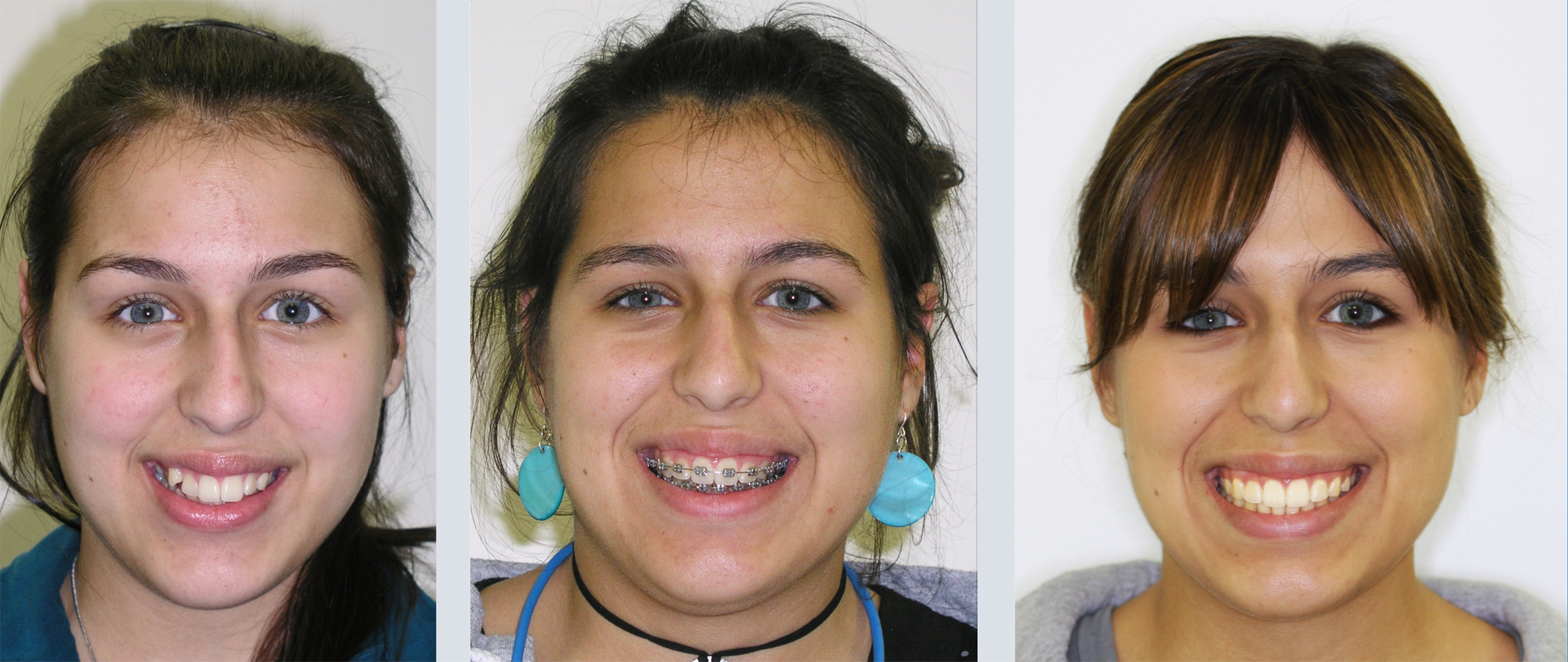Braces – Orthodontic ServicesSwansea, MA
Traditional orthodontic braces remain the most durable teeth-straightening treatment available to this day. Patients undergoing corrective treatment no longer have to experience the “brace-face” look as orthodontic braces have become less bulky and more discreet through advancements in dental technology. They are also the only orthodontic appliances that allow patients to express themselves by changing the brackets’ colors every few weeks.
Orthodontic braces are available at Barrington-Swansea Family Dental in Swansea and the surrounding area. We can handle your teeth straightening needs to help you discover your best smile. Call us today at 508-439-4074 to schedule an appointment or learn more about our services.
Signs a Patient Needs Braces
Individuals of all ages may need braces for more than just aesthetic reasons. Properly-aligned teeth are essential for a healthy oral cavity and prevent many dental health problems from arising or developing further. Malocclusions, or misaligned teeth, are the greatest indicators of a patient needing braces. This condition occurs when the top and bottom teeth or jaws do not align properly when the mouth is closed. Examples include overbites, underbites, crossbites, or open bites.
Other signs that indicate a person needs braces include:
- Being prone to biting the tongue, the roof of the mouth, or the inside of the cheek accidentally
- Mouth breathing
- Early or late loss of baby teeth
- Jaws that click or make other sounds
- Teeth that are crooked or crowded
- Teeth that do not come together
- Thumb-sucking or using a pacifier past the age of two
In some cases, having braces treatment earlier in a person’s life guides the teeth into position, requiring patients to have a second treatment round later in adolescence or adulthood. However, patients of all ages can benefit from orthodontic braces treatment.
“Malocclusions, or misaligned teeth, are the greatest indicators of a patient needing braces.”

Free Orthodonic Consultation
See photos of patients’ Makeovers
"I was always very self conscious about my bucky teeth. The doctor explained everything to me and always took the time to give me the best care possible. I love my new smile, it was definitely worth getting the braces!" B.K.
The doctor, as New England Chapter President of the International Association of Orthodontics provides seminars in orthodontics and children's dentistry. This organization is the longest continually operating non-specialty school and study group, dedicated to the latest advances in children's dentistry and orthodontics. He is also a certified Invisalign ® provider.
The Doctor also participates in orthodontic training through NYU dental School and other organizations. All patient's receive an orthodontic evaluation as a part of their regular dental exam.
Orthodontics for Children
As a part of our emphasis on children's dentistry, we have incorporated orthodontics into our practice. An orthodontic screening is done for each child. This allows us to diagnose problems in tooth position and facial growth at an early age. Then, if necessary, a treatment plan is developed to optimize the effectiveness of treatment and to decrease cost. Interceptive orthodontics utilizes appropriately timed early treatment to deal with orthodontic problems and helps growth progress in a more normal fashion.
Orthodontics for Adults
Many of our adult patients have received orthodontics as a part of a comprehensive treatment plan to address all of their dental problems. This is often combined with periodontal treatment (for healthy bone and gums) and other therapies to replace missing teeth. Adults appreciate the wide range of alternatives to traditional braces (such as Invisalign ®) that we provide. These can eliminate or reduce the need for traditional braces.
Pros and Cons of Orthodontic Braces
The greatest disadvantage of orthodontic braces is that they are more apparent than any other corrective treatment. They are also heavier on the teeth and may cause slight discomfort, especially during tightening sessions. Lastly, it is more difficult to clean both the braces and the teeth themselves, requiring patients to exercise thorough hygiene practices.
Although there may be a few disadvantages of orthodontic braces, there are substantial benefits. The benefits of traditional orthodontic braces include their durability and effectiveness, controllability, versatility, and variety. Metal is far more durable and effective than ceramic or plastic, which are used with other appliances. These braces allow the dentist to control tooth movement and tighten them as needed to keep treatment going as intended. Their versatile nature makes braces the only available treatment for severe or complicated cases, and the variety offers patients freedom of expression.
“The benefits of traditional orthodontic braces include their durability and effectiveness, controllability, versatility, and variety.”
The Process of Receiving Braces
The first step in receiving braces is the preliminary consultation appointment, in which we will physically examine the mouth and take full X-rays. We will also take an impression using a special mold material or conduct a 3D scan to curate the individualized braces. The braces are typically ready within two to three weeks.
On the next visit, the general dentist will start by cleaning and drying out the patient’s mouth. The first step in applying the hardware is to attach a bracket, the square piece that holds the wires, to each tooth. The brackets are fixed to teeth with bonding glue and, once secured, are connected using a wire from bracket to bracket. The wires remain attached by putting small bands on top of them, and the patient can then select different colors for their bands. The entire process takes about two hours to complete.
“The first step in receiving braces is the preliminary consultation appointment in which we will physically examine the mouth and take full X-rays”
Adjusting to Orthodontic Braces
The first few days following treatment may cause slight discomfort and require minor adjustments. Braces work right away, and patients often experience soreness in the gums as they feel their teeth moving. Dental professionals recommend patients wash their mouths frequently with warm salt water and take pain relievers to relieve initial discomfort as they adjust to their new braces.
Patients may also need to make adjustments to their diet to protect their appliances and teeth. Avoid sticky foods such as caramels or other soft candies and hard or crunchy foods that could damage the braces, such as popcorn. Additionally, certain fruits and vegetables, including oranges, pineapple, and spinach, can get stuck in braces and should be cut into small pieces. The dental team will provide the patient with a list of foods and beverages to avoid.
“Patients may also need to make adjustments to their diet to protect their appliances and teeth.”
Maintenance and Follow-Ups
To properly maintain the braces and a healthy mouth, it is essential to brush the braces, teeth, and gums after each meal and floss at least once daily. Food can easily get stuck between the brackets and wires, making it difficult to clean the teeth and mouth thoroughly. The dental team will provide the patient with a special brush and floss designed specifically for braces.
Follow-up appointments are generally scheduled every four to six weeks to replace worn-out rubber bands, check progress, and make adjustments to the wires to make sure that the patient’s teeth are moving in the right direction. The dental team will replace the elastic bands on each bracket during each visit and may also take out and replace the wire. Adjustment sessions typically take around 20 minutes. Missing follow-up appointments can cause delays in the total treatment time or disrupt treatment progression.
“Missing follow-up appointments can cause delays in the total treatment time or disrupt treatment progression.”
Orthodontic braces can help you achieve a straighter and healthier smile. Our team at Barrington-Swansea Family Dental is here to make the process as easy as possible. Call us today at 508-439-4074 to schedule an appointment or learn more about our services.
Questions Answered on This Page
Q. What are some signs that indicate a person needs braces?
Q. What are the pros and cons of orthodontic braces?
Q. What is the process for receiving braces?
Q. How do patients adjust to orthodontic braces?
Q. What are the maintenance and follow-ups required with braces treatment?
Frequently Asked Questions
Q. Do braces hurt?
A. The application of braces should not hurt. However, patients may experience some discomfort in the first week as they adjust to the pressure. We will prescribe pain relief medications and highly recommend saltwater rinses to alleviate any discomfort during treatment.
Q. What is the average duration of treatment?
A. Braces treatment can take anywhere from six months to three years, depending on the patient’s case. Some factors that can influence the duration of treatment include:
- The patient’s age
- The severity of the misalignment
- The patient’s compliance with treatment
- The patient adhering to specific guidelines
Our dental team will take the time to discuss each patient’s treatment time during the initial consultation appointment.
Q. Are braces bad for the teeth?
A. Braces themselves do not damage the teeth or their enamel. However, poor oral hygiene during treatment can greatly affect the teeth as tooth decay deteriorates enamel. Patients with braces have to be diligent about cleaning their mouth and ensure they brush and floss between the braces and crevices between the teeth.
Q. Do braces move the teeth every day?
A. Braces do move the teeth every day in small increments. Patients may or may not feel this movement. The treatment duration is due to these precise but gradual adjustments.
Q. Are there any side effects of braces treatment?
A. Braces may cause some irritation, discomfort, and jaw pain. Some side effects, although rare, include tooth decay and deterioration, decalcification, allergic reactions, and root resorption. Contact our office immediately if you notice these symptoms. We can address your concerns during follow-up appointments to ensure symptoms do not worsen or affect treatment.
Contact Us
Barrington-Swansea Family Dental is located at 2302 US-6 Swansea, MA 2777.





